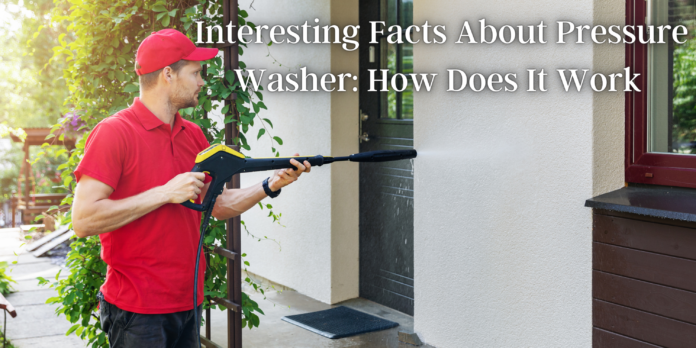A pressure washer works by forcing pressurized water through several tiny apertures to generate a forceful liquid jet capable of removing dirt and grime off hard surfaces like patios, walls, and automobiles.
A hose linked to an intake valve on the exterior of the washer connects domestic pressure washers to the mains water supply. The engine rotates an inclined swashplate at nearly 3,000 revolutions per minute when the machine is turned on. This swashplate converts circular motion into reciprocating (up and down) movement, which is used to drive spring-loaded pistons responsible for pulling water into the apparatus.
When the broad end of the angled swash plate passes over the top of the pistons, it pushes them down, causing them to drop. On the other hand, the pistons rise to their original places as the narrow end of the plate passes. Through a one-way valve, the rising pistons suck water into the pump.
Water cannot be squeezed; it will always go to a lower pressure zone when pressure is applied. As a result, as the piston drops and begins to push down on the newly entering water, the liquid must leave via another one-way valve, this time emptying into the output hose with enormous force.
Enjoy Your Visit to https://giraffetools.com/collections/pressure-washer to own one for yourself!
Washing Machines
The high-pressure water rushes down the output hose until it reaches the gun’s closed trigger. The water is stopped here, and the motor is momentarily shut off. The engine starts up again when the user pulls the trigger, guiding a constant spray of high-pressure, high-speed water out the small hole in the nozzle.
Residential pressure washers have a detergent reservoir, which has the additional advantage of further breaking down grime. It also has a water-cooled motor, which makes it run more smoothly.
When you’re under duress
As the name implies, pressure is what powers these devices, but what exactly is it? The force exerted on a solid, liquid, or gas that causes the material’s molecules to be squished is pressure. A pressure washer’s pump raises the pressure on the liquid, forcing water molecules to clump together. Water, unlike air, cannot be compressed.
Therefore, the crammed water molecules push against the container’s walls. If the fluid can move, the molecules must travel to any spot where the pressure is lower as the pressure rises; in the case of the pressure washer, this means via the output valve. A power washer may increase the pressure of a standard garden hose by 15 to 50 times or more.
Pistons with springs
The engine pumps the pump at high speed to pull water in. This one has a three-piston axial flow pump, which acts as a suction pump, drawing water in via one end and pushing it out the other end of the pump and into the hose.
The pressure washer’s pump is powered by an electric motor powered by the mains electrical supply. For added efficiency, this model has a water-cooled induction motor.
The outlet hose must be strengthened with wire mesh and additional layers of plastic due to the tremendous pressure of water going out of the machine. It has a portable pistol with a trigger (which also activates and deactivates the motor) that the operator may use to direct the water. The nozzle’s high-pressure water jet is then utilized to remove caked-on filth from hard surfaces.
Intake valve
A hose connects the unit’s intake valve to the mains water supply. The water supply is filtered via a fine mesh filter before entering the pump to remove any minute particles that might harm the pump.










